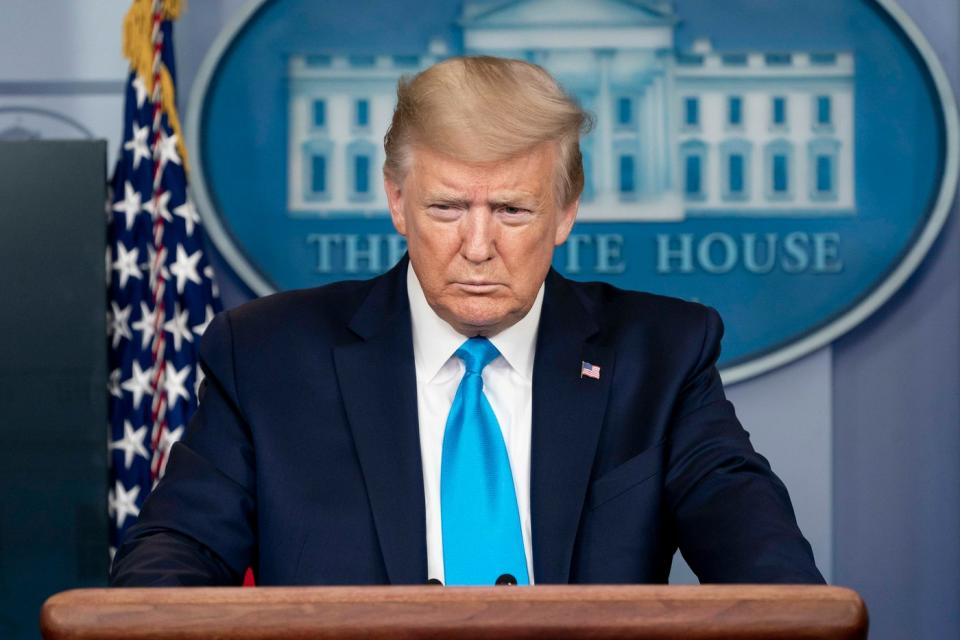Are Stocks Going to Plunge if Donald Trump Wins and Congress Is Split? Here’s What History Says About Stock Market Returns in This Scenario.
A little over five months from now, Americans will head to the polls or mail in their ballots to determine which direction our country heads over the next four years.
Although there are plenty of aspects to lawmaking that have absolutely nothing to do with what happens on Wall Street or with corporate America, it’s undeniable that the fiscal policy changes passed on Capitol Hill can impact what happens with the U.S. economy and stock market.
With the Republican National Convention less than two months away, former President Donald Trump looks to have run away with the presidential nomination. As of May 21, Trump had secured 2,181 delegates, which is nearing two times the 1,215 delegates needed to win his party’s nomination.
During Trump’s first term as president (Jan. 20, 2017 – Jan. 19. 2021), the ageless Dow Jones Industrial Average (DJINDICES: ^DJI), broad-based S&P 500 (SNPINDEX: ^GSPC), and growth-powered Nasdaq Composite (NASDAQINDEX: ^IXIC) delivered respective gains of 56%, 67%, and an eye-popping 138%!


However, stock market returns under Trump were quite different between his first two years in the Oval Office, where he enjoyed a unified Republican Congress, and his final two years, where Democrats controlled the House and Republicans held the Senate.
Would a Donald Trump win in November, coupled with a split Congress, set the stock market up for disaster? Let’s take a closer look at what challenges a Trump presidency and split Congress might face, and allow history to be the ultimate judge of what’s to come.
Are stocks going to plunge with a Trump win and a divided Congress?
To be fair, there isn’t any predictive data point on the planet that can guarantee what Wall Street is going to do based on who becomes president and whether Congress is divided or unified. Ye, some very clear headwinds await. Some of these could be based on policy, while others are a threat to the Dow, S&P 500, and Nasdaq Composite regardless of who’s sworn in on Jan. 20, 2025.
On the policy side of things, Trump and the Democrat-controlled portion of Congress would likely feud over a number of issues. The most important for Wall Street would be taxation (both personal and corporate).
Arguably the most memorable law passed during Trump’s presidency was the Tax Cuts and Jobs Act (TCJA), which reduced personal income tax rates and created a flat corporate tax rate of 21% (down from 35%). While Trump would likely push for the continuation of the TCJA rates, which are on track to sunset by Dec. 31, 2025, Democrats are unlikely to be supportive of such a move, given the nation’s rising national debt and ongoing fiscal deficit. Note that changes to the corporate tax rate are permanent (i.e., won’t sunset after 2025).
The prospect of an increase in personal income tax rates is concerning. If consumers have less disposable income, there’s a real chance it could dent the growth prospects of Wall Street’s fastest-growing companies.
But macro headwinds, which are agnostic to who wins come November, may be an even bigger threat to Wall Street than any policy-based bickering between Trump and congressional Democrats.
WARNING: the Money Supply is officially contracting.
This has only happened 4 previous times in last 150 years.
Each time a Depression with double-digit unemployment rates followed.
pic.twitter.com/j3FE532oac
— Nick Gerli (@nickgerli1) March 8, 2023
A perfect example is what’s been happening to U.S. M2 money supply over the last two years. M2 money supply takes into account everything in M1, which is cash, coins, and demand deposits in a bank account, and adds in savings accounts, money market accounts, and certificates of deposit (CD) below $100,000.
Most investors and economists pay little attention to money supply because it’s been rising without interruption for the better part of nine decades. An expanding economy requires more capital in circulation to keep the proverbial hamster on its wheel.
However, we’ve witnessed a historic decline in M2 since April 2022. After peaking at $21.722 trillion in April 2022, M2 has fallen by $881 billion, as of the April 2024 update from the Board of Governors of the Federal Reserve. While this aggregate drop of 4.06% isn’t all that impressive considering that M2 expanded by an all-time record of 26% on a year-over-year basis during the height of the COVID-19 pandemic, it nevertheless represents the first notable decline of more than 2% in M2 since the Great Depression.
As you can see in the post on X from Reventure Consulting CEO Nick Gerli, year-over-year declines of at least 2% in M2 money supply are incredibly rare. When back-tested to 1870, there have only been five instances of meaningful M2 declines: 1878, 1893, 1921, 1931-1933, and 2023. All four of these previous M2 declines were associated with an economic depression and high unemployment.
The good news for whichever president wins come November is that the Federal Reserve and federal government have the tools and understanding to avoid the steep declines in the U.S. economy that were seen in the late 19th and early 20th centuries. Nonetheless, declining M2 money supply has historically been a harbinger of a big move lower in the U.S. economy and stock market.
In other words, there’s always the chance stocks could plunge with Trump as president and Congress divided.


Here’s what history says happens when Republicans win the presidency and Congress is split
With the understanding that Donald Trump and a split Congress would undoubtedly face challenges, let’s dig into the meat and potatoes and see what history has to say about stock market returns when Republicans win the presidency and Congress is split.
Let’s start with the best news of all: No matter how you arrange the puzzle pieces, with regard to which party controls the White House and whether Congress is unified or divided, the stock market has delivered a positive average annual return under every scenario.
According to calculations by Forbes’ columnist and president of Integrity Wealth Management Mike Patton, a “split Congress,” regardless of which party controls the White House, has delivered the most robust returns for investors of any scenario between 1946 and 2020. When the leadership of Congress was split over this 75-year span, the Dow Jones delivered an average annual return of 12.9%!
Retirement-focused website Retirement Researcher took things even further and examined the annualized returns of the S&P 500 from 1926 through 2023. What Retirement Researcher found was 34 years with a Republican president and a split Congress. In these years, the S&P 500 averaged a 7.33% annual return. Interestingly, this is less than half the 16.63% average annual return under a Democrat as president with a divided Congress.
Nevertheless, the point remains the same: A Republican president and a split Congress historically leads to decisively positive returns for investors.
Although the stock market and U.S. economy aren’t tied at the hip, a growing economy tends to have a positive impact on corporate America.
Since World War II ended, there have been a dozen recessions. Out of these 12 recessions, nine were resolved in under a year, while the remaining three failed to surpass 18 months in duration. Comparatively, most periods of economic expansion were sustained for multiple years, and once in a while reached the 10-year mark. The economic cycle isn’t linear, and that undeniably benefits the Dow, S&P 500, and Nasdaq Composite.
As you can clearly see in the post on X from the researchers at Bespoke Investment Group, disproportionately long periods of economic growth translate into extended bull market rallies on Wall Street. Since the Great Depression began in September 1929, the average bear market in the S&P 500 has lasted only 286 calendar days. Meanwhile, the typical bull market has stuck around 1,011 calendar days, or roughly 3.5 times as long.
Further, 13 of the 27 S&P 500 bull markets over the previous 94 years lasted longer than the lengthiest bear market in more than nine decades.
Although a stock market plunge is a possibility if Trump wins in November and Congress remains divided, history shows that long-term-minded investors are sitting pretty no matter what happens this election season.
Don’t miss this second chance at a potentially lucrative opportunity
Ever feel like you missed the boat in buying the most successful stocks? Then you’ll want to hear this.
On rare occasions, our expert team of analysts issues a “Double Down” stock recommendation for companies that they think are about to pop. If you’re worried you’ve already missed your chance to invest, now is the best time to buy before it’s too late. And the numbers speak for themselves:
-
Amazon: if you invested $1,000 when we doubled down in 2010, you’d have $20,357!*
-
Apple: if you invested $1,000 when we doubled down in 2008, you’d have $35,898!*
-
Netflix: if you invested $1,000 when we doubled down in 2004, you’d have $348,787!*
Right now, we’re issuing “Double Down” alerts for three incredible companies, and there may not be another chance like this anytime soon.
*Stock Advisor returns as of May 13, 2024
Sean Williams has no position in any of the stocks mentioned. The Motley Fool has no position in any of the stocks mentioned. The Motley Fool has a disclosure policy.
Are Stocks Going to Plunge if Donald Trump Wins and Congress Is Split? Here’s What History Says About Stock Market Returns in This Scenario. was originally published by The Motley Fool






